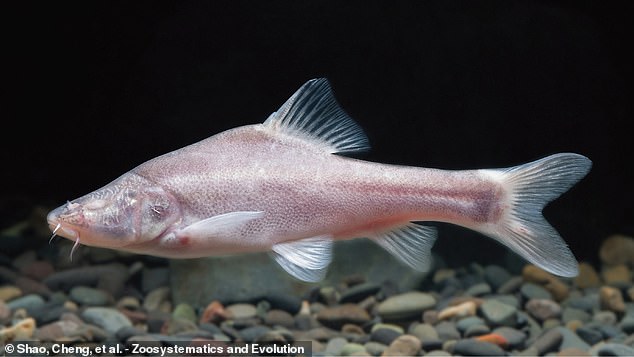A pink, eyeless creature has been discovered in an underwater cave in China that scientists say could answer mysteries about evolution.
Researchers announced a new species of cave fish that lives deep in the underground currents of the Wujiang River system, he is blind and his eyes look like black dots beneath his skin.
However, some of the fish appeared to have weak vision, which the team said could offer “exceptional cases for evolutionary studies.”
It is now a race against time to save new species that are already considered at risk of extinction due to pollution and invasive species.
Seven specimens of a new species of eyeless cavefish (pictured), each with a golden stripe down their back, have been discovered swimming in China’s underground river systems.

Ecologists and conservationists identified their first sample of the new pink cavefish in 2019, but it took years more field studies deep in the underground streams of the Wujiang River system (pictured above) to capture enough fish to prove it. It is a new species.
The researchers named their cavefish ‘Guiyang golden-line barbel,’ or more technically Sinocyclocheilus guiyangin honor of several closely related species of goldenline barbel, as well as the city of Guiyang, which is near the home of the new fish’s Cave River.
“Fish diversity in the Yangtze River basin of Guiyang City, the most urbanized area in Guizhou, has long been underestimated,” the researchers said.
Up to 66 related Sinocyclocheilus Fish species have been found living in the Pearl River basin south of Guizhou, but only six species have been found in Guizhou’s Yangtze River basin and its local tributary of the Wujiang River.
The fish research team suspects that even more undiscovered fish will be found in the vast river caves of the Wujiang system.
The geology of this Wujiang river system, in the central province of Guizhou, is mainly limestone and other carbonate rocks known as “karst”, which dissolve easily in water creating drainages and sinkholes in this region of south-central China .
“Like the Pearl River Basin, the Wujiang river system also features extensive and well-developed karst forms,” the scientists wrote in their new study, “which has provided good conditions for the formation of underground river systems.”

Some specimens of the new fish are completely eyeless (A, top left), but others have small “very reduced eyes, partially covered by skin” (B, top right), the team said. This range of blindness and weak vision in one species offers “exceptional cases for evolutionary studies,” they note.
The ‘Guiyang goldline barbel’ grows to about 5 inches long, with shorter than average ‘barbels’ – the whisker-like protuberances around a fish’s face that fish in particular depend on. caverns to navigate and find food.
‘Beards spread on Sinocyclocheilus “The species is common,” the researchers wrote, “as the long barbels better detect water flow and help forage in underground water systems that are marked by permanent darkness and food scarcity.”
Currently, it remains a mystery why this Guiyang cavefish did not evolve these longer, more useful rods, or why it lacks a horn-like structure on its head common to its cavefish cousins. with barbs.
As the team reported in the magazine Zoosystematics and Evolution This Tuesday, the new cavefish also has “degenerated” scales, and a generally shorter snout and fins than others Sinocyclocheilus species.
But the new cavefish has a bright golden marking on its back, between its head and dorsal fin, similar to other related barbel fish.
“This species is currently only known from an underground stream that flows into the Wujiang River,” according to the scientists, which could suggest a smaller habitat.

The fish research team suspects that even more undiscovered fish will be found in these huge river caves: “Just like in the Pearl River Basin, the Wujiang river system also […] has provided good conditions for the formation of underground river systems,” they wrote (species sighting map)

While there are over 200 documented species of ‘obligate’ (blind) and/or ‘troglobiotic’ (cave-dwelling) fish worldwide, found on every continent except Antarctica, each individual species occurs in limited numbers ( above, the new cave fish in nature)
While there are over 200 scientifically documented species of ‘obligate’ (blind) and/or ‘troglobiotic’ (cave-living) fish worldwide, and they are found on every continent except In Antarctica, each individual species occurs in limited numbers.
Many of them, including America’s own ‘Hoosier cavefish’ (Amblyopsis hosieri) and ‘Alabama Cavefish’ (Speoplatyrhinus poulsoni) exist only within their own closed cave networks, which puts them at greater risk of endangerment or extinction.
The fish study team that discovered the new species (a collaboration between Huazhong University of Science and Technology, the Chinese Academy of Sciences and several local wildlife agencies) hopes that further identification will help protect these creatures that They swim in caves from human invasion of their homes. .
‘The new species is the first described troglobiotic species of the genus Sinocyclocheilus in the Wujiang River,” they noted.
‘[It] “It faces a high risk of extinction,” they said, “underscoring the urgency of adopting habitat protection measures within its limited range.”


